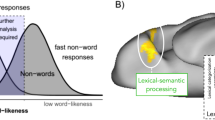Abstract
This paper describes a computerized diagnostic test for the assessment of basic literacy skills in Dutch. Central in this test is a skill labeledword image, referring to the subject's implicit knowledge of orthographic structure. Test norms were obtained in a group of reference subjects. The most notable trend found in the standardization study was that the development of word image performance showed a nonlinear, U-shaped trend. Two case studies are reported. A supplementary validation study, based on test data collected from standard reference groups of normal and poor readers, demonstrated that word image performance is significantly related to between-group differences.
Similar content being viewed by others
References
Assink, E. M. H. (1987). Algorithms in spelling instruction: The orthography of Dutch verbs.Journal of Educational Psychology, 79, 228–235.
Bowerman, M. (1982). Starting to talk worse: Clues to language acquisition from children's late speech errors. In. S. Strauss (Ed.),U-shaped behavioral growth. New York: Academic Press.
Bowerman, M. (1985). Beyond communicative adequacy: From piecemeal knowledge to in integrated system in the child's acquisition of language. In K. E. Nelson (Ed.),Children's language (Vol. 5), Hillsdale, NJ: Erlbaum.
Bowey, J. A. (1986a). Syntactic awareness and verbal performance in relation to reading skill and ongoing reading comprehension monitoring.Journal of Experimental Child Psychology, 41, 282–299.
Bowey, J. A. (1986b) Syntactic awareness and verbal performance from preschool to fifth grade.Journal of Psycholinguistic Research, 15, 285–308.
Brus, B. Th., & Voeten, M. (1972).Eén minuut test [One-minute test]. Nijmegen: Berkhout.
Ehri, L. C., & Wilce, L. S. (1979). Does word training increase or decrease interference on a Stroop task?Journal of Experimental Child Psychology, 27, 252–364.
Ehri, L. C., & Wilce, L. S. (1983). Development of word identification speed in skilled and less skilled beginning readers.Journal of Educational Psychology, 75, 3–18.
Fisher, F. W., Shankweiler, D. & Liberman, I. Y. (1985). Spelling proficiency and sensitivity to word structure.Journal of Memory and Language, 24, 423–441.
Gardner, H., & Winner, E. (1982). First intimations of artistry. In S. Straus (Ed.),Ushaped behavioral growth. New York: Academic Press.
Gombert, J. E. (1992).Metalinguistic development. New York: Harvester Wheatsheaf.
Henderson, L., & Chard, J. (1980). The reader's implicit knowledge of orthographic structure. In U. Frith (Ed.),Cognitive processes in spelling. London: Academic Press.
Karmiloff-Smith, A. (1985). Language and cognitive processes from a developmental perspective.Language and Cognitive Processes, 1, 61–85.
Karmiloff-Smith, A. (1987). Function and process in comparing language and cognition. In M. Hickmann (Ed.),Social and functional approaches to language and thought. New York: Academic Press.
Klima, E. S. (1972). How alphabets might reflect language. In J. F. Kavanagh & I. Mattingly (Eds.),Language by ear and by eye. Cambridge, MA: MIT Press.
Schadler, M., & Thissen, D. M. (1981). The development of automatic word recognition and reading skill.Memory and Cognition, 9, 132–141.
Seidenberg, M. S., & McClelland, J. L. (1989). A distributed, developmental model of word recognition and naming.Psychological Review, 96, 523–568.
Stavy, R., Strauss, S., Orpaz, N., & Carmi, G. (1982). U-shaped behavioral growth in ratio comparisons. In S. Straus (Ed.),U-shaped behavioral growth. New York: Academic Press.
Strauss, S. (1982). Introduction. In S. Straus (Ed.),U-shaped behavioral growth. New York: Academic Press.
Stroop, J. R. (1935). Studies of interference in serial verbal reactions.Journal of Experimental Psychology, 18, 643–662.
Treiman, R., & Hirsh-Pasek, K. (1985). Are there qualitative differences in reading behavior between dyslexics and normal readers?Memory and Cognition, 13, 357–364.
Tunmer, W. E., Nesdale, A. R., & Wright, A. D. (1987). Syntactic awareness and reading acquisition.British Journal of Developmental Psychology, 5, 25–34.
Vellutino, F. R., & Scanlon, D. M. (1982). Verbal processing in poor and normal readers. In C. J. Brainerd & M. Pressley (Eds.),Verbal processes in children: Progress in cognitive development research. New York: Springer.
Young-Loveridge, J. M. (1985). Use of orthographic structure and reading ability: What develops?Journal of Experimental Child Psychology, 40, 439–449.
Author information
Authors and Affiliations
Rights and permissions
About this article
Cite this article
Assink, E., Kattenberg, G. Computerized assessment of verbal skill. J Psycholinguist Res 22, 427–444 (1993). https://doi.org/10.1007/BF01074345
Issue Date:
DOI: https://doi.org/10.1007/BF01074345



